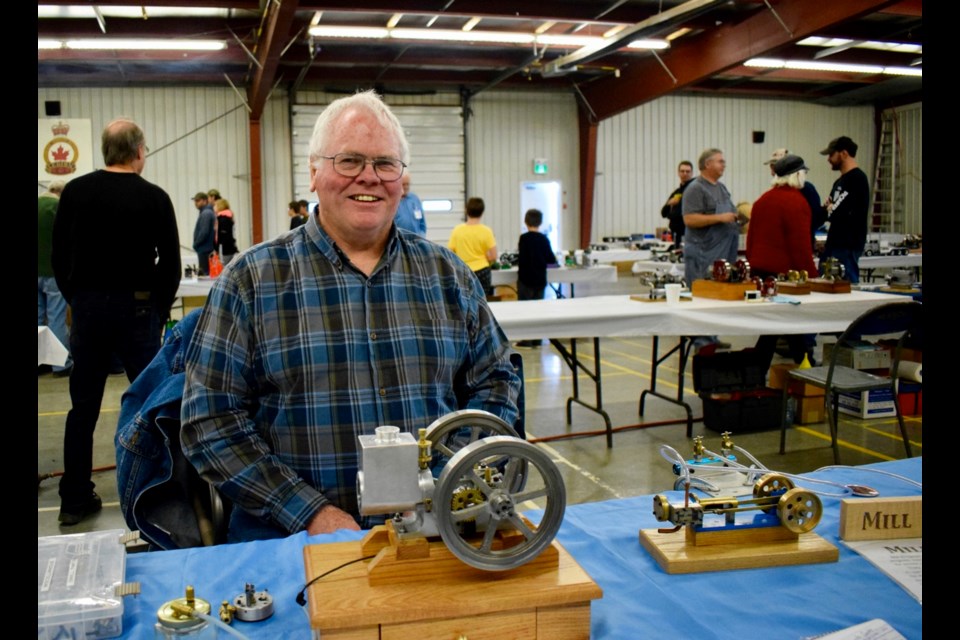The Estevan Model Engineering Show for the 32nd time attracted engineers, inventors and hobby admirers from all across North America. Some of them came to share their projects, others were seeking ideas and advice from like-minded people, and some came to see the exhibits and enjoy the event.
Kelly Tytlandsvik, who’s been organizing the longest-running show of its kind in North America for all 32 years, said that this time there were 39 exhibitors, which is a bit less than before. Even though some hobbyists couldn’t make it because of weather or health issues, the show still had a lot of variety and attracted many guests. Participants came from Idaho, Manitoba, Alberta, Montana, Wyoming, both Dakotas, Minnesota and from all over Saskatchewan.
Thirty-two years ago an event started at the Estevan Shoppers’ Mall with just 12 people, who were fascinated about building miniature working engines and engine-operated models. One of Tytlandsvik’s biggest projects – a 4440 Northern steam locomotive built at 3/4 inches of a scale, which guests could see on display this weekend - was started that same year and wasn’t completed until 2017.
About 15 years ago the show overgrew the mall and moved over to the Wylie Mitchell building, where it now occurs every year the weekend after the Canadian Thanksgiving. What once was just a friendly geek gathering for most participants now turned into an annual tradition.
“I’ve got to where it’s just an email that goes out to let people know about the show and come out. It’s the same weekend every year… So everybody got to know that, that the show is the same time all the time. So we come out Friday morning to set tables up. Local people come and help. Two hours, we are set up and ready to go and people start showing up,” said Tytlandsvik.
People participating in the show have very different occupations, but all of them are into the same hobby. Salesmen, power plant technicians, electricians, geologists, jewellery salesmen, water well drillers, you name it, at the show all of them were open to sharing their stories, passion and details about their engines.
Even though a number of participants referred to themselves as a bit crazy, the only thing that was insane were the amazing projects of all scales and types these people created.
Most projects started with blueprints, which after the years in the machine shop would turn into a real model. Linda and Bob Cooke of Winnipeg brought models of gasoline and steam one to eight cylinder engines, which also all first existed only on paper.
“I buy plans from somebody else who has designed them. And then I get raw material and make them according to the plan… This one took 14 years,” said Bob pointing at the Challenger V-8 gas engine similar to the ones used in 1940 Cadillacs. “I have a machine shop. My machines help me to get the parts the right size, then you have to assemble everything and then you have to hope that it’s going to work.”
Even though there is a plan in place in the beginning, throughout the complicated process hobbyists sometimes make mistakes, but sometimes the blueprints they work with also have mistakes.
“When you are making something in miniature, there is a lot more pressing for accuracy than in the whole size engine,” said Bob, who admitted that he was more into building the projects rather than operating them later, but he always hopes that the new creation can work.
For a number of exhibitors, engine building was a retirement hobby. Thus, Merv Young of Estevan got into building mill steam engine models about five years ago to keep his brain occupied.
“I wanted to challenge myself mentally when I retired,” said Young.
He’s never done machining, so getting into a completely new sphere was a real challenge. Young got to meet Tytlandsvik, who steered him towards getting the right equipment and then models.
“It gives you some purpose; with all machining the purpose is building a model,” explained Young, who used to work as a physical education teacher.
He always worked on his own cars, so engines weren’t a totally new world, but he had to learn a lot and he keeps learning along the way. Young started with a small model and joined the Estevan Model Engineering Show as soon as it was completed, also about five years ago. But that was just the beginning.
“Each time I do an engine I try to do something a little more complicated so I have to think,” said Young.
His latest project, a hit and miss engine, wasn’t completely put together as Young was trying to improve compression in it and was seeking advice from other exhibitors.
“Some people at the show will help. They are very helpful in giving suggestions. They, maybe, made one of these,” said Young.
Every exhibitor had many models and stories to share with each other and with visitors. Tytlandsvik said that every year at the end of the first day, they invite all participants to come out for supper, which allows them even more room for learning from each other and socializing, keeping this spread-out community together.
He also noted that the sponsors’ support has been helping him to keep this narrowly specialized but very exciting and educating event going for many years.



